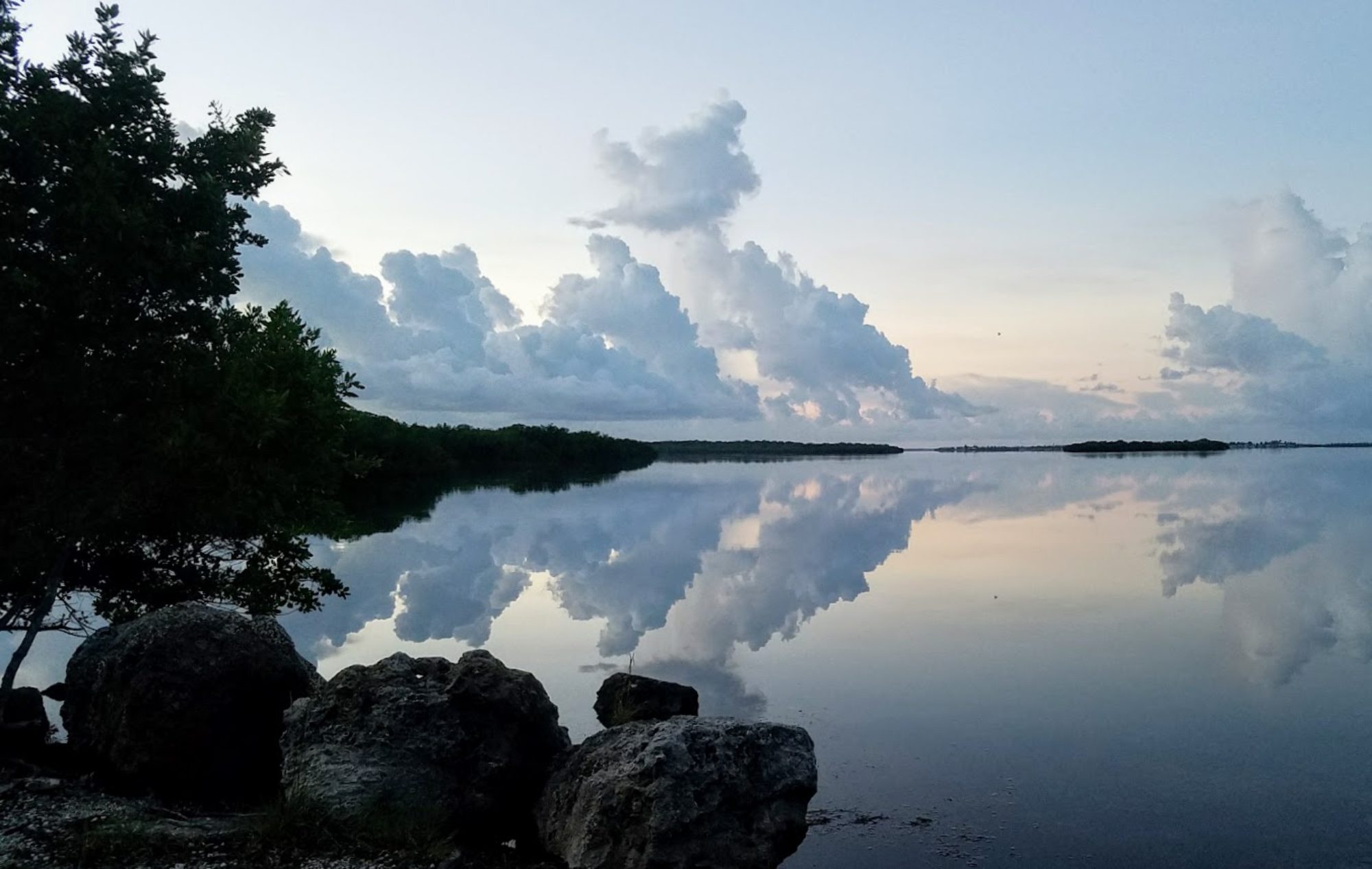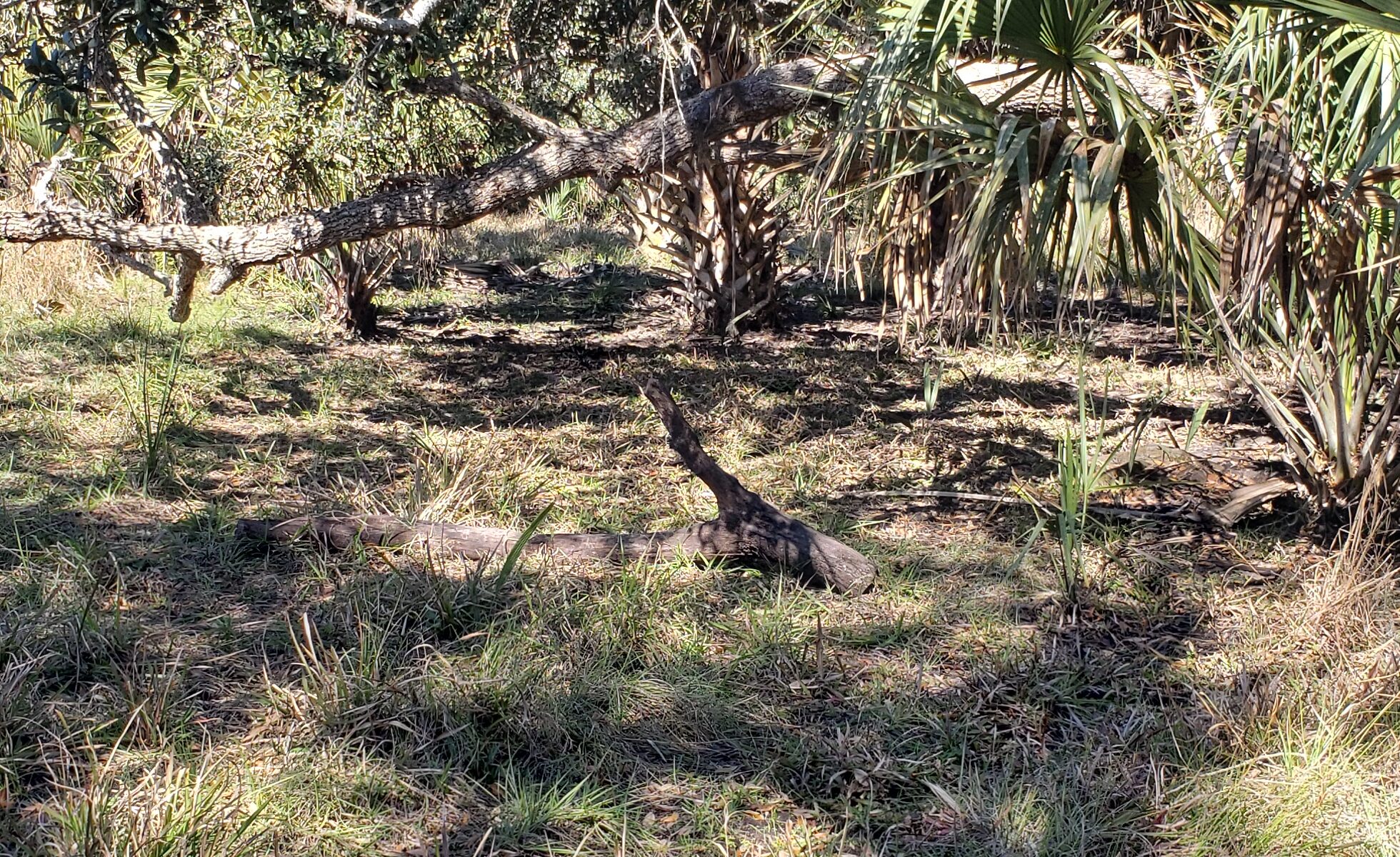This state park is remarkable for many reasons, but the two most important are these: it is the largest remaining expanse of dry prairie in the state of Florida, and the first park in Florida to be recognized as a Dark Sky Site by International Dark Sky Association. While the park is a dry prairie, you can still expect to get your feet wet during the summer months when rain and bugs are far more troublesome than they were for our February camping trip.
A Brief History
Developed around the remains of the Peavine Railroad, the park is rich in history. The Peavine Railroad, which once ran from just south of Kissimmee into what is today Kissimmee Prairie State Park in Okeechobee County, was built to bring investors to the area during the land boom. A lovely picture of dry, bug-free paradise is visible during the winter months, but during the summer, Kissimmee Prairie is something entirely different: wet, buggy, humid, and not at all the winter paradise investors were sold on! The railroad became “just” a road, and the hardy farmers and ranchers who remained used the road until the late 1940s, when it was fenced off by a large property holder.
During World War II, the military bought up large tracts where they trained bombing crews. It is still possible to find live ordnance on the prairie today! This bombing may be partially responsible for the excellent condition of the prairie, since the bombs often caused fires. Fire is an important component of dry prairie health, since it prevents overgrowth, fertilizes the prairie, and provides excellent habitat for many prairie species. At the conclusion of the war, cattlemen purchased the land on one side of the Kissimmee River, and the Avon Park Air Force Range is still active on the western boundary of the Preserve. In 1997, Kissimmee Prairie Preserve State Park was established when Florida acquired 48,000 acres.
Campground
The campground at this park is, like other Florida State Parks, clean as a whistle. There are three camping areas: the Family Loop, the Astro Pads, and an Equestrian Loop. The main bathhouse is located within the Family Loop. It is clean but looks old, with rusty sinks. But no one camps because they want fancy sinks, and the water pressure is good and the hot water is hot — color me a happy camper! The Equestrian Loop has a vault toilet, but no showers. The Astro Pads have no toilets and no showers. All campers have access to the Family Loop bathhouse, where they may also use the washer and dryer and the dishwashing sink.
One dumpster serves all the camping areas, and it is convenient to none of them. The ranger station sells ice, and firewood is also available for sale.
When we arrived at our campsite, the previous campers had left us a lovely painted rock. We felt so welcome! We left it for the next campers because it was such fun to find it.

Our picnic table was rickety; it appears that many of the nuts had fallen off or been removed from the bolts, but it was still serviceable. The table was smaller than at other campsites and did not have the extra cooking space that some of them have. Campsites on the family loop were smaller than the equestrian campsites, but we still had plenty of room to spread out and enjoy ourselves. Most of the family loop sites are shaded and because the loop is small, no one is too far from the comfort of the bathhouse.
Most Polite Raccoons
On our first night, we heard a raccoon rummaging around our site. He made a quick investigation and left within 10 minutes. We always put our food away and minimize anything that will interest critters, but on this night I had overlooked a jar of coffee. The next morning, the coffee was just gone. I knew it had to have left with the raccoon, but I did not find it until the next morning. The racoon was not able to get into the jar, so no harm, no foul! This raccoon came back every evening but was neat and tidy. The only evidence of his visit was a bit of dried grass on the table and footprints on the mat outside the pop-up. On our last night, Steve got a look at it, and it was a very healthy-looking ‘coon!
Oh, that SKY!
We go to bed very early when we camp, but we also get up in the middle of the night because. . .well, when you hit your 60s you’ll know why. At any rate, when we climbed out of the popup and looked up we were stunned by the stars. We live in a dark area and often see the Milky Way, but our skies have NOTHING on Kissimmee Prairie skies. There were so many stars we could hardly identify Orion! It was disorienting! The Plieades were clearly visible, along with constellations I have never seen before. When the moon rose in the very early morning, it was literally bright enough to read by. Astro Pad campers, who are prohibited from using any light that is not red, must really get their eyesful of stars. I could not help but think of the millions of generations before me who have looked into the skies and felt the hand of God at work. . .I know I did. I would love to be there during a meteor shower! Did I think to take a picture? No. But you can see some spectacular photos here.
Hiking at Kissimmee Prairie State Park
The opportunities for hiking are numerous here. I was somewhat overwhelmed when I started looking at the map of trails, but settled on the Prairie Loop trail as a must do, and we also liked the looks of Hammock Trail, a much shorter trail that begins behind the ranger station.
With over 100 miles of trails in the Park, we hiked less than 15. Steve and I both want to return to see more, because there is so much more to see! Nearly 25 miles of the Florida Trail run through Kissimmee Prairie State Park from south to north. Information on this trail is widely available elsewhere, including this site as a starting point.
The trail map available in the park is helpful. Take a few moments to orient yourself and be prepared for small markers at the trail intersections.
Hammock Trail
We stumbled upon Hammock Trail with its red blazes on our first full day at Kissimmee Prairie. The trail is a short loop and offers you the opportunity to hike in a shaded hardwood hammock, and it is lovely. We spent about 10 minutes watching a doe who was watching us with caution but not fear.
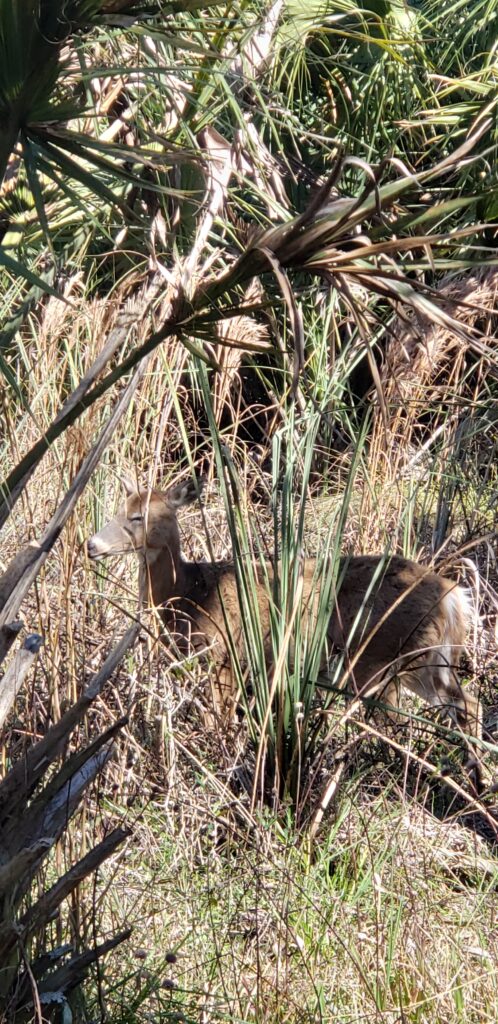
We enjoyed the Hammock trail, but if you really want to see the magnificence of Kissimmee Prairie, take the Kilpatrick Prairie Trail off to the south (depending on which way you walk the loop, you will see the mowed trail either just before or just past a small footbridge), and then take a left turn at the small brown “Z” marker. As soon as we were out of the hammock and onto the prairie trail, Steve noticed Florida Pennyroyal (Piloblepis rigida) blooming. We also saw a couple different types of St. John’s-wort, milkwort, Fetterbush lyonia, and more.
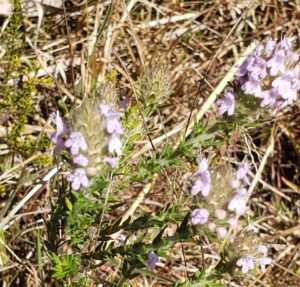
At one point, we noticed that the trail conditions were very much like the trails at Hontoon Island (fine white sand with areas of peat, looks dry and acidic), and we started looking closely to see if we could find any pink sundew. It did not take long to be rewarded with several colonies of these sweet little carnivorous plants. For such a tiny plant, they inspire big joy in my heart!
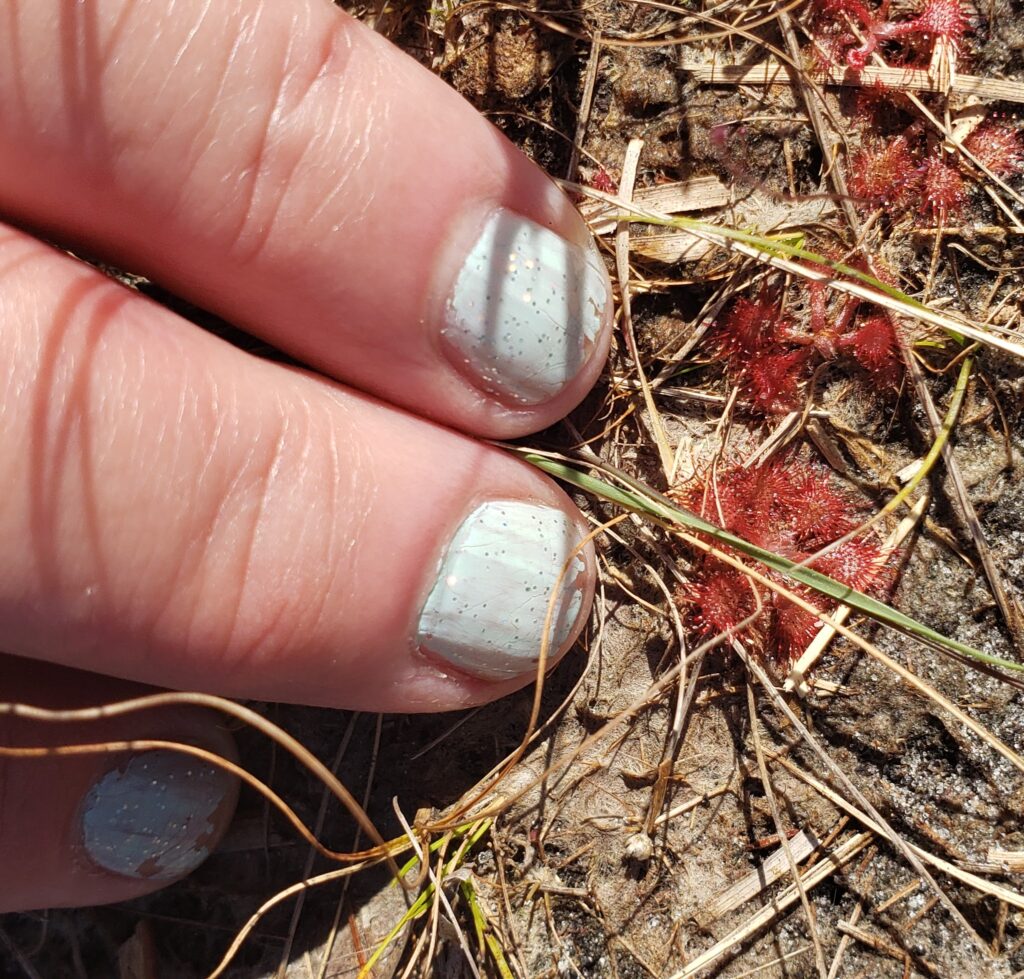
We also so lots of fun tracks, and I am determined to make myself a plaster casting kit to throw in the backpack. We could have made some lovely casts!

Hammock Trail would be fine for a family with young children. I’d keep them on the trail, though, because there are wet areas where gators live happily. Pets are not allowed on this trail.
Prairie Loop Trail
Prairie Loop Trail is a 4.6 mile loop blazed with green. There is a tiny parking area right at the trailhead, but it is very small and it will be more convenient to walk to the trailhead if you’re camping.
This trail begins at the end of the equestrian camping loop. There’s an information kiosk and ten steps from that is the beginning of the trail. You’ll start in a hardwood hammock with twisted live oaks and other small trees. Soon, you’ll be presented with lovely vistas of broad prairie.
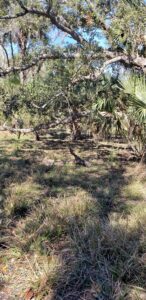
There are many spots that look like they’d be perfect for a picnic, and because you are in and out of several hammocks, the first half of the trail has lots of shady spots.
About halfway around the loop you will pass a primitive campsite. On the day we hiked, there was a young woman with her tent set up, stretched out and enjoying a book on the sunny morning. She looked so very happy! She was looking forward to a good night of stargazing, she said, and had left the rainfly off her tent. Fortunately, the coldest of the weather had passed and so we hope she saw more stars than she ever dreamt possible.
At the point where the Prairie Loop Trail meets the Grasshopper Sparrow Trail (marked with a post labeled “DD”), if you head west on Grasshopper Sparrow Trail, there is a rookery that is not labeled on any map we’ve seen. We heard the croaking of herons before we saw them. There were herons, ibises, egrets, vultures, and crested cara caras roosting, feeding, and just standing around looking lovely. There was also a large gator on the far shore. We were looking for a good place to see the birds clearly and perhaps sit for awhile, but we made so much noise that we scared the birds into the sky and the gator into the water. Although we waited about 15 minutes for the birds to come back, they must have found another pleasant spot. I did manage to get proof that we saw the cara caras, which made my morning.
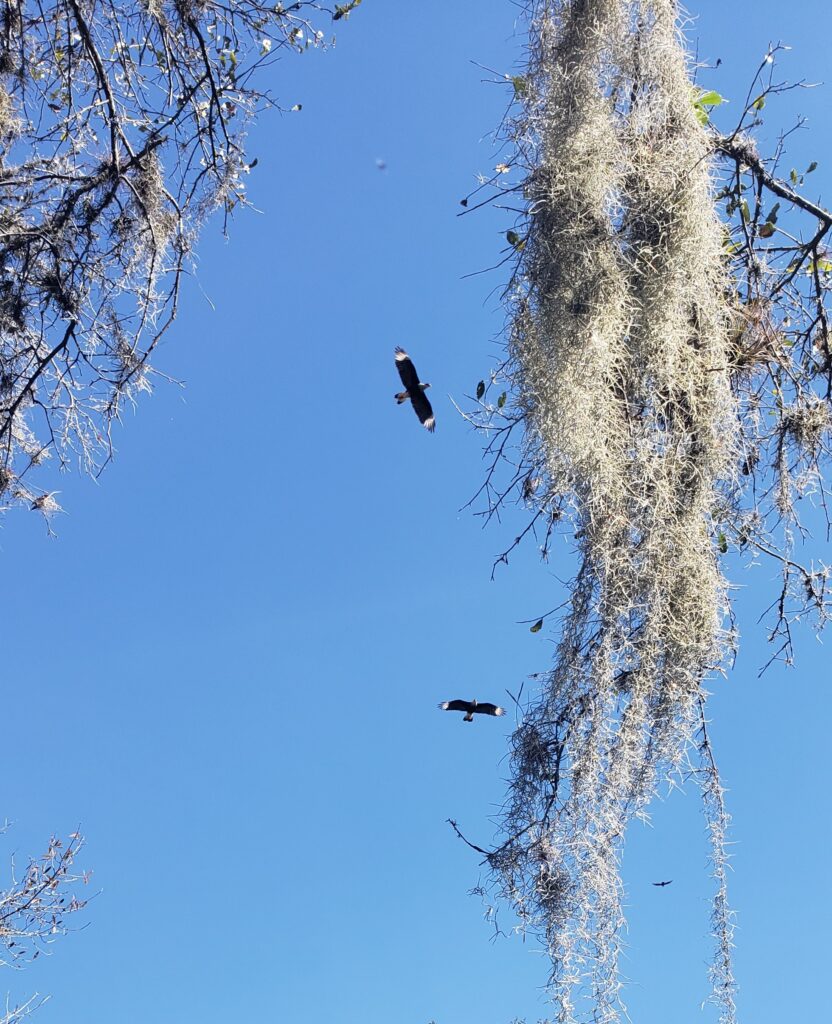
We saw blooming violets, orange milkwort, and Florida pennyroyal along the trail. We also saw liatris, which makes me think the prairie will be spectacular in the spring.
About a mile after the DD marker, we took the right onto Military Trail, which marks the last mile and a half of the Prairie Loop Trail. At first, I wondered why the trail had been built to end this way, because there was not a lot to see. The trail is a hard sand road with marsh on either side. I was beginning to get bored and tired by the final mile, but about a half mile before the end of the trail we noticed a couple sitting on the roadside. When we asked what was the most interesting thing they had seen, they laughed and pointed into the small pond in front of them. There were THIRTEEN baby gators! So Military Trail is probably not so boring during the wet season when the big gators will be closer to the trail. These gators were young enough that Mama Gator was probably nearby, but we saw no evidence of her.
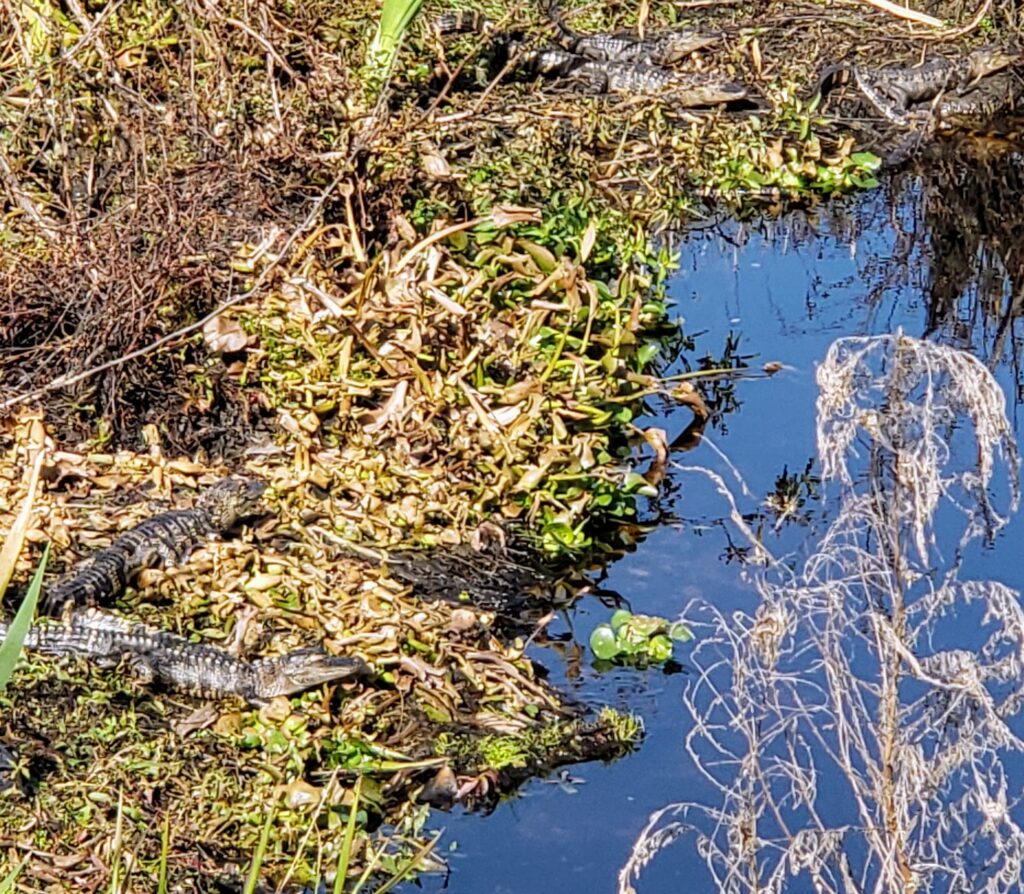
Final thoughts. . .
As always, pack plenty of water if you’re going to hike. I really enjoyed using the SEEK app on my phone to identify plants; this is a good place to try out new apps for identification of plants and animals, but download them before you arrive because there is no wifi! Of course, you can always carry field guides in book for pamphlet form. Because much of the prairie is in full sun, you’ll be glad you remembered your sunscreen. Above all, get out there and rest your eyes on the prairie. It will reveal itself to you in new ways with every turn of the trail.
